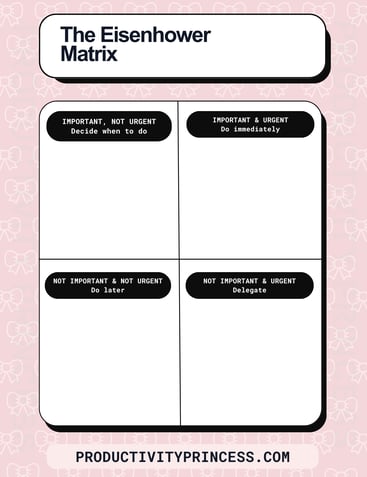Mastering the Eisenhower Matrix: A Step-by-Step Guide to Task Prioritization
Overwhelmed by tasks? Master the Eisenhower Matrix with this step-by-step guide. Learn to prioritize urgent vs important tasks, reduce stress, and boost productivity using proven time management strategies.
PRODUCTIVITYTIME & TASK MANAGEMENT
Do you ever feel like your to-do list is a never-ending avalanche? You’re not alone. According to the American Psychological Association (APA)(https://www.apa.org), 60% of employees report feeling overwhelmed by their workload, often because they’re drowning in tasks but don’t know where to start (APA, 2023). The problem isn’t a lack of effort—it’s a lack of clarity.
Enter the Eisenhower Matrix, a revolutionary time management framework that helps you cut through the chaos. Named after President Dwight D. Eisenhower, this method is built on a simple but powerful idea: “What is urgent is seldom important, and what is important is seldom urgent.” As the Harvard Business Review (HBR) (https://hbr.org) notes, this matrix isn’t just about sorting tasks—it’s about reclaiming control over your time and reducing decision fatigue (HBR, 2022).
In this guide, you’ll learn how to master the Eisenhower Matrix, distinguish urgent vs important tasks, and finally prioritize what truly matters.
What Is the Eisenhower Matrix?
The Eisenhower Decision Matrix is a 2x2 grid that categorizes tasks based on two factors: urgency and importance. Here’s how it breaks down:
Quadrant 1: Urgent & Important – “Do Now”
Crises, deadlines, or problems that need immediate attention.
Example: A project due today, a broken website, or a family emergency.
Quadrant 2: Not Urgent & Important – “Schedule”
Tasks that drive long-term goals but lack urgency.
Example: Exercise, strategic planning, or learning a new skill.
Quadrant 3: Urgent & Not Important – “Delegate”
Time-sensitive tasks that don’t contribute to your goals.
Example: Routine emails, meetings, or interruptions.
Quadrant 4: Not Urgent & Not Important – “Eliminate”
Distractions or busywork that add zero value.
Example: Mindless scrolling, gossip, or binge-watching TV.
The matrix’s origins trace back to Eisenhower’s legendary productivity, but it was popularized by Stephen Covey in his 1989 classic The 7 Habits of Highly Effective People. Research in the Journal of Applied Psychology (https://www.apa.org/pubs/journals/apl/) found that matrix users reported 28% lower stress levels by minimizing “firefighting” tasks (2021).
Step-by-Step Guide to Using the Eisenhower Matrix
Ready to try it? Let’s break it down:
Step 1: List All Your Tasks
Write down everything on your plate—work projects, personal errands, even hobbies.
Step 2: Categorize Each Task
Quadrant 1: Deadline-driven client report, sick child.
Quadrant 2: Planning a vacation, drafting a business proposal.
Quadrant 3: Answering non-urgent calls, scheduling meetings.
Quadrant 4: Checking social media, reorganizing your desk.
Step 3: Take Action
Delete Quadrant 4 tasks. As productivity guru James Clear writes in Atomic Habits, “Every habit should deliver a benefit.” https://productivityprincess.com/5-books-to-read-to-become-more-productive If it doesn’t, ditch it.
Delegate Quadrant 3 tasks. Use tools like Slack or Asana to hand off responsibilities. https://productivityprincess.com/if-you-like-taking-digital-notes-try-this
Schedule Quadrant 2 tasks. Block time on your calendar—this is where magic happens!
Do Quadrant 1 tasks immediately—but cautiously. HBR warns that spending >25% of your day here leads to burnout (2021).
Pro Tip: Start small. Focus on 3–5 tasks daily to build momentum.
Urgent vs Important: Understanding the Core Difference
Why does this distinction matter?
Urgent tasks demand instant attention but often lack long-term value (e.g., a ringing phone).
Important tasks align with your goals but are easy to postpone (e.g., writing a book).
A McKinsey report (https://www.mckinsey.com) revealed that 40% of professionals prioritize urgency over importance, leading to burnout and stalled careers (2020). The fix? Ask yourself: “Will this matter in 5 years?” If not, it’s likely not important.
Integrating the Eisenhower Matrix with Other Techniques
Supercharge your matrix with these productivity strategies:
Time Blocking
Pair Quadrant 2 tasks with dedicated time slots. Author Cal Newport, in Deep Work, argues that uninterrupted blocks boost focus by 500%. https://productivityprincess.com/5-books-to-read-to-become-more-productive
Project Time Tracking
Use tools like Toggl Track to audit where your hours go. If you’re spending too much in Quadrant 3, it’s time to delegate!
Advanced Tips for Maximizing Productivity
Weekly Reviews: Reassess your matrix every Sunday. David Allen’s Getting Things Done method calls this a “mind sweep” to reset priorities.
Avoid Quadrant Creep: Turn off non-essential notifications. If a task isn’t urgent, don’t let others pressure you into making it so.
Tools and Apps to Implement the Eisenhower Matrix
1. Todoist: Pre-built Eisenhower Matrix templates let you sort tasks in seconds.
2. Trello: Create quadrant-based boards for visual clarity.
3. ClickUp: Automate prioritization with AI-driven labels.
4. Eisenhower.me: A dedicated app for matrix enthusiasts.
Consider some productivity boosting gadgets like the ones listed here: https://productivityprincess.com/9-gagdets-that-will-boost-your-productivity
Real-World Applications and Success Stories
Salesforce Case Study: After training teams on the matrix, Salesforce reported a 35% drop in overtime hours (Forbes, 2022).
Entrepreneur Testimonial: “I reclaimed 10+ hours a week by delegating Quadrant 3 tasks,” shared a CEO in [Entrepreneur Magazine](https://www.entrepreneur.com) (2023).
Building Sustainable Habits
The Eisenhower Matrix isn’t a quick fix—it’s a lifestyle. Start by tackling one quadrant a day. Celebrate small wins, like deleting distractions or scheduling “me time.” As James Clear says, “Habits are the compound interest of self-improvement.”
Ready to transform chaos into clarity? Your journey to task prioritization mastery starts now. Download out Eisenhower Matrix Template and sign up to get freebies and stay in the loop.


Download your FREE Eisenhower Matrix Template!
Stay Productive,
FTC: This post contains affiliate links. If you make a purchase through these links, I may earn a small commission at no extra cost to you. Thank you for your support! As always, all opinions are my own.

Inspiration
Empowering you to maximize your productivity daily.
© 2025. All rights reserved.
